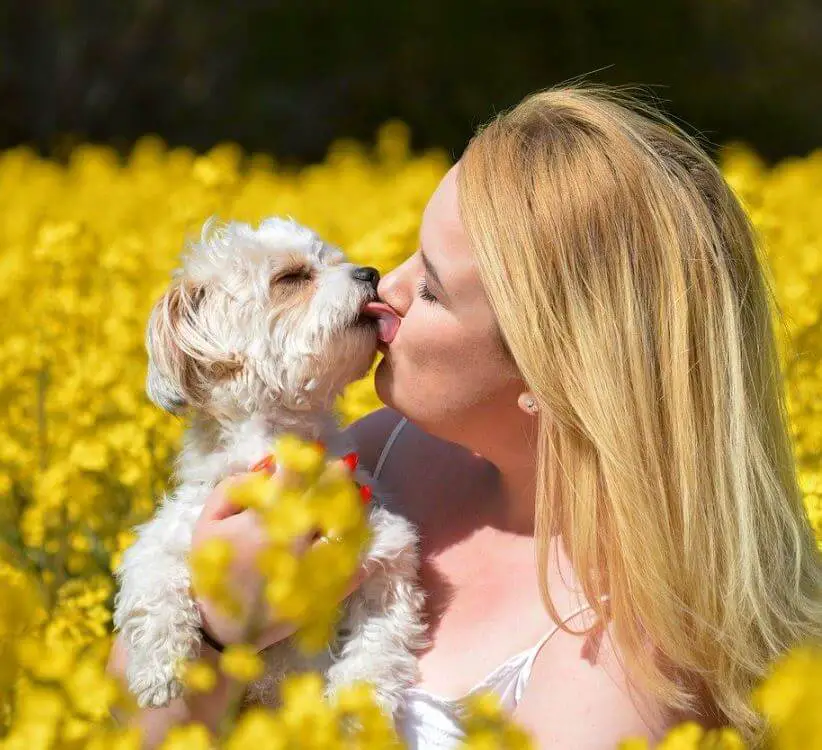Have you ever experienced the sandpaper-like sensation of your dog’s tongue exploring your skin, leaving you curious about the messages hidden within their slobbery affections? Today, we embark on a journey to unravel the secret language of canine kisses, delving into the myriad meanings behind each wet, licky encounter.

The Canine Lick as a Communication Symphony:
Beyond being mere slobbery greetings, dog licks serve as a complex form of communication. This symphony of canine interaction involves taste, touch, and instinct, conveying a range of messages:
1 – Affection Expression:
Consider it a slobbery declaration of love! Unable to articulate words, your dog showers you with wet affection, strengthening the bond between you and your furry companion.
2 – Communication Tool:
Dogs’ saliva contains pheromones, conveying chemical messages. A gentle lick can serve as a means for your pup to understand your mood, learn about you, and reciprocate by sharing their own emotions.
3 – Grooming Instinct:
Rooted in their ancestry as pack animals, dogs inherit strong grooming rituals. Your pup may be giving you a loving “once-over,” fostering cleanliness and connection.
4 – Exploration and Curiosity:
For dogs, exploring the world with their tongue is unparalleled. A curious lick may involve deciphering dinner remnants or mapping the landscape of your face.
Deciphering the Lick: Tailoring the Message to the Tongue:
Not all licks are created equal. Learn to interpret the subtext of your dog’s slobbery symphony:
1 – The Gentle Nudger:
Soft, rhythmic licks express sweet affection and trust, signaling your pup’s happiness in being close to you.
2 – The Excited Licker:
A boisterous, full-body lick accompanied by a wagging tail screams, “Welcome home! Playtime now!” Prepare for a wet tsunami of canine joy.
3 – The Focused Frenzy:
Rapid, concentrated licks around your mouth or hands often signify a desire for treats. Get ready for puppy dog eyes and an irresistible tongue offensive.
4 – The Inquisitive Explorer:
A slow, methodical lick, combined with sniffing and head tilts, indicates your pup’s curiosity about you and a desire to investigate.
Beyond Kisses: Understanding Other Licky Behaviors:
Licking isn’t limited to affection and exploration; it can also reveal deeper emotions:
1 – Self-Soothing Soother:
Nervous licking may serve as a self-soothing mechanism during stressful situations.
2 – Puppy Play Puddles:
Playful licking between puppies or with humans strengthens bonds and develops social skills.
3 – Anxious Antennae:
Excessive licking may be a sign of anxiety or boredom. Pay attention to other body language cues and consult your vet if concerned.
Licking Etiquette: When to Celebrate and When to Consult:
While embracing slobbery love, be mindful of the message:
1 – Clean Kisses Welcome:
Enjoy the shower of affection and reciprocate the love.
2 – Excessive Licking Pause:
If licking becomes obsessive or causes skin irritation, investigate potential physical discomfort or allergies.
3 – When in Doubt, Ask the Vet:
Excessive licking could be a sign of underlying medical conditions. Seek professional advice if worried.
The next time your furry friend paints your face with their tongue, remember, it’s more than a messy gesture—it’s a window into their emotions and needs. Learn the language of the lick, deepen your bond, and revel in the joys of having a four-legged friend who communicates in kisses, not words.
Bonus FAQ:
1 – Can dog licks spread diseases?
While generally harmless, dog saliva can carry bacteria. Practice good hygiene and wash your face after enthusiastic licking.
2 – Should I let my dog lick my wounds?
While their saliva may have healing properties, consult your doctor before allowing your dog to lick open wounds.
3 – How can I discourage excessive licking?
Redirect attention with toys or treats, providing alternative forms of stimulation like walks and playtime.
